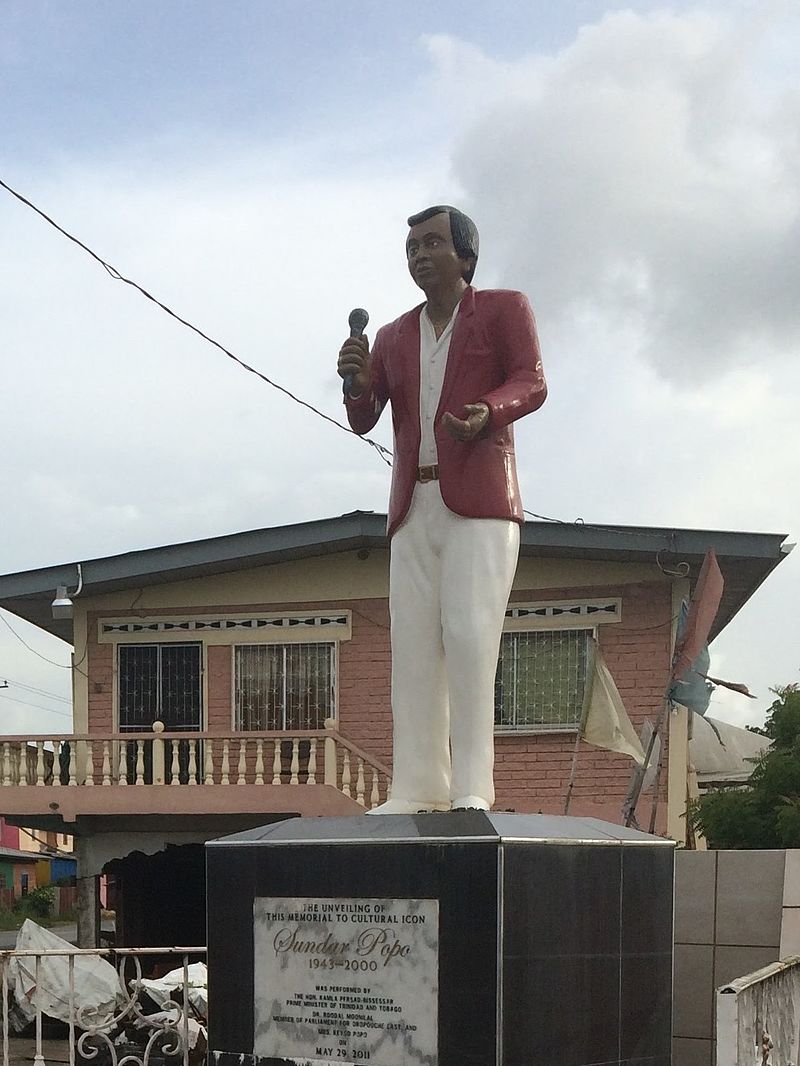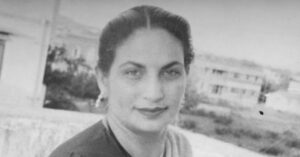The Caribbean Artist Who Inspired Amitabh Bachchan & Bollywood to Sing His Songs
Sundar Popo, a legendary recording artist from Trinidad and Tobago and pioneer of an eclectic genre of music called Chutney, was once considered as the Frank Sinatra-Kishore Kumar of the Caribbean.

In 1969, Sundar Popo released his debut song ‘Nana and Nani’, a monster hit which left an indelible mark on the cultural fabric of Trinidad & Tobago, a dual island nation in the Caribbean.
Sung largely in English, but interspersed with Hindi and Bhojpuri words, it chronicles the drinking habits of his grandparents. Not only did the song, which marked the emergence of a new genre of music called ‘Chutney’, capture the attention of the Indo-Caribbean and Afro-Caribbean communities but also found its way back to the motherland — India.
Bollywood megastar, Amitabh Bachchan, was one among many connecting links between Sundar Popo’s music and India. He incorporated the song ‘Chadar Bichawo Balma’ into his medleys during his live stage performances back in the early 1980s.
There were other connecting links including acts like Babla (younger brother to legendary composer duo of Kalyanji-Anandji) and Kanchan, who are best known for work in Chutney and Indian folk music. Going further, renditions of Popo’s song ‘Kaise Bani’ were recorded for movies like ‘Bhaiya Dooj’ (1985) and the Salman Khan-starrer ‘Dabangg 2’.
However, in an old interview, Popo is heard saying that he wasn’t pleased with composers appropriating his melodies. He said, “Everyone who is singing chutney today, they follow my melody. Lots of chutney singers now are taking my melodies because I was the first one who went and did chutney. They don’t have a chutney song without my melody, they take a piece, a piece, a piece, even in Indian films they use my melodies.”
Nonetheless, Popo did perform with luminaries of popular Hindi cinema like Anup Jalota (recorded an album together in 1980) and Kishore Kumar. But such was his popularity outside the Caribbean that he did a concert held at the legendary Madison Square Garden arena in New York in the late 1990s. More than fame or recognition, however, his music helped establish a long-lost direct link between the Indo-Caribbean community and India.
Popo, who was regularly seen wearing a red lounge suit, would go on to record more than 15 albums, and 165 songs and win a litany of awards. Sadly, he passed away in 2000 at the age of 56 due to health complications brought on by his love for alcohol. The then prime minister of Trinidad & Tobago personally came to attend his funeral. The government even facilitated the construction of a statue in Debe, South Trinidad, commemorating Sundar’s incredible life.

Music in his blood
Born on 4 November 1943 in the small town of Barrackpore on Trinidad island, Sundar grew up in a household where his mother was a singer and his father, an accomplished Tassa drummer. They would perform at various weddings and other local functions, taking a young Popo with them. Music was in his blood and he grew up singing from a very early age.
By his early teens, he was already singing bhajans at temples and weddings in Barrackpore for just 15 to 30 cents a show. While training under classical vocalist Ustad James Ramsawak, he made ends meet by working as a watchman for a factory in his hometown.
According to a 1996 interview, he learned Bhojpuri songs from the women in his family. He said, “My mother had a group of ladies who used to sing at the farewell night [part of the wedding cer-emony]. As young children, they couldn’t leave us home so they took us with them…”
Another scholar Rajiv Mohabir, in a 2019 paper published in Anthurium, a Caribbean Studies journal, wrote, “He experimented with a new syncretic style that blended English, Creole, Bhojpuri, and Hindi languages to express his unique linguistic identity and poetics that arose in the space of contact that is the Caribbean. He was able to use English in his music to reach a growing English dominant audience while maintaining sonorous and thematic ties to a local coined variety of Indian-ness.”
It was a meeting at a ‘matikhor’ (pre-wedding song festival) in Princes Town with local radio host and music promoter Moean Mohammed which changed the course of Sundar’s life forever. Following this meeting, Popo recorded his breakthrough hit ‘Nana and Nani’ in 1969, which tells the fascinating, yet quirky, story of a win-loving grandfather and grandmother.
The song, according to author Nate Rabe, “revolutionised Caribbean music by mixing English and Bhojpuri lyrics (‘aage aage Nana chale, Nani goes behind/ Nana drinking white rum/ Nani drinking wine’) and setting the stage for what would eventually be loved as chutney”.
In a 2020 blog post by Cuttage, the author delves into some of the major themes encapsulated by the song. “Unlike Chutney songs of today which romanticise and glorify the abuse of alcohol, Popo shows that the use of alcohol by the older generation of indentured servants/sugarcane workers provided a coping mechanism and became a part of daily life,” the author wrote.
Following the success of ‘Nana and Nani’, Popo went full steam ahead with his music career and composed albums combining local Trinidadian music with traditional Indian folk music.
Today, he is best known for songs like ‘Scorpion Gyul’, ‘Kaise Bani’, ‘I Wish I Was A Virgin’ and ‘Saas More Lage’ marked by the sound of the dholak, tabla, shehnai-sounding clarinet and other Indian folk instruments, besides upbeat Tassa beats and even the odd brass section. These songs spoke of romance, sexual desire, mythology, liquor and their everyday struggles.
Acts like Baba and Kanchan from Mumbai garnered a lot of success and popularity from covering his songs, particularly the rendition of ‘Kaise Bani’. These renditions and covers brought “him to a wider international audience”, and led to tours of “India, Europe, the United States, Canada, Africa, Fiji, Mauritius and other parts of the Caribbean”.
What is Chutney music?
The first Indians were brought to Trinidad in 1845 as indentured labourers to work on sugar plantations owned by the British. As a genre of music, chutney traces its origins to a time when these workers, largely from eastern Uttar Pradesh and Bihar, were taken to the Caribbean.
As Nate Rabe noted in an article for Scroll.in:
“Emerging out of the traditional north Indian female practice of singing wedding songs to brides on the eve of their marriages, chutney music has over the years added Hindi filmi rhythms, modern electronic and western instruments and calypso beats to create a spicy genre of intoxicating dance music. Men may have now taken centre-stage but not by any means have they displaced the women. Rather, the music has given women an opportunity to move out of the shadows where they once sang their saucy tunes, to shake and strut their stuff in public.”
In a 2019 paper published in Anthurium, scholar Rajiv Mohabir wrote:
Chutney music is the fast-paced, sometimes ribald, dance music of Indo-Caribbean communities named for the popular condiment of mango and hot peppers…There is no one ingredient that is expendable, in fact, the whole creation of the condiment is contingent on the correct proportions of cumin, mustard, spice and fruit. Likewise, this genre of music is aptly named and described as Chutney because it combines many different Caribbean elements in its making. The instruments used to produce this music are essential and also serve as metaphors for “Indian-ness” while often beating Soca and Calypso-themed rhythms.
Going further, he adds, “Traditional instruments include the harmonium, the dholak, dhantal, and the human voice. In contemporary Chutney music of Drupatee, Rikki Jai, Terry Gajraj and others, electronic instruments such as synthesisers and drum machines are ubiquitous.” If you found our stories insightful, informative, or even just enjoyable, we invite you to consider making a voluntary payment to support the work we do at The Better India. Your contribution helps us continue producing quality content that educates, inspires, and drives positive change. Choose one of the payment options below for your contribution- By paying for the stories you value, you directly contribute to sustaining our efforts focused on making a difference in the world. Together, let’s ensure that impactful stories continue to be told and shared, enriching lives and communities alike. Thank you for your support. Here are some frequently asked questions you might find helpful to know why you are contributing?

Of course, some musical elements in chutney music can be traced to India, but others have emerged as a result of cultural interaction in the multicultural settings of the Caribbean. What Popo did was bring all these elements together in his music without hiding its source culture before passing away on 2 May 2000 at his home in Monkey Town, Barrackpore.
Sources:
Mohabir, R 2019 ‘Chutneyed Poetics: Reading Diaspora and Sundar Popo’s Chutney Lyrics as Indo-Caribbean Postcolonial Literature’. Anthurium, 15(1): 4, 1–17
Dark Beginnings: An Analysis of Sundar Popo’s “Nana & Nani” by Cutter; Published on 20 July 2020 courtesy Cuttage blog
A quick guide to Sundar Popo, the Don of Trinidadian chutney music by Nate Rabe; Published on 31 August 2014 courtesy Scroll.in
Sundar Popo remembered: He died 18 years ago by Carolyn Kissoon; Published on 1 May 2012 courtesy Daily Express (Trinidad)
Audience touched by Sundar Popo story by Yvonne Webb; Published on 14 June 2104 by Trinidad & Tobago Guardian
(Edited by Yoshita Rao)
This story made me
-
97
-
121
-
89
-
167
















